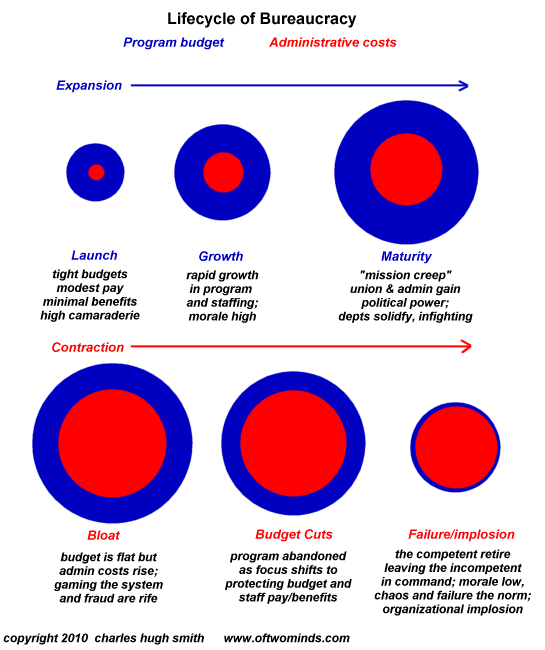America's legacy systems are like stars about to go super-nova.
There are two problems with the vast, sprawling legacy systems we've inherited from the past: they're dysfunctional and cannot be fixed/reformed. The list of dysfunctional legacy systems that cannot be truly reformed is long: Social Security, with its illusory Trust Funds and unsustainable one-to-two ratio of beneficiaries to full-time workers; Medicare, 40% fraud and ineffective/needless care; the healthcare system (if you dare even call the mess a system), 40% paper shuffling and 25% defensive medicine and profiteering; weapons procurement--the system works great if you like cost overruns and programs that take decades to actually produce a weapon; higher education--costs have skyrocketed 700% while studies (Academically Adrift) have found that fully a third of all college graduates learned little of value in their four years; the financial system--now that we've given the Federal Reserve oversight over Too Big To Fail Bank practices, do you really think we'll ever get rid of TBTF banks?
One place to start an investigation of any legacy system is to ask: how would we design a replacement system from scratch? The gulf between a practical, efficient replacement system and the broken legacy system is a measure of the legacy system's dysfunction.
We all know why legacy systems cannot be reformed or replaced: each has a veritable army of constituents and vested interests. Every single person drawing a check or payment from the legacy system fears reform of any kind, as each fears that their place at the feeding trough might be threatened.
As a result, reform is necessarily superficial, a simulacrum of real reform that satisfies the PR need to "fix the system" but actually hardens the system against future reform by adding layers of complexity that act as defensive complexity moats.
There is a fundamental asymmetry between those threatened by reform and the reformers. The reformers are trying to save the system from eventual collapse, but the benefits of their efforts often fall to the cohort of young people who have not yet become voters or entered the workforce; these citizens don't exist politically.
Meanwhile, those drawing paychecks, benefits or payments from the legacy system will fight with every fiber of their being to protect every cent of "their fair share." (Needless to say, every share is fair and deserved.) Those resisting reform are fighting to the death, so to speak, while the reformers have no equivalent motivation or political persuasion.
Corporations threatened by reform launch a ceaseless lobbying/PR attack on the reform, either watering it down, eviscerating the regulatory structure or co-opting the reformers into accepting a superficial reform rather than walk away with nothing.
Legacy systems have hardened into bureaucracies whose primary purpose is defending the fiefdom's budget and power from any threat. I prepared this chart to illustrate the life-cycle of bureaucracy:
As revenue flatlines and pressure for real reform mounts, the embattled institutions find that propaganda and facsimiles of reform are cheaper "solutions" than real reform. This is the key driver behind the flood of propaganda and all the phony "reforms" laid out in thousands of pages of befuddling bureaucratic self-preservation.
Real reform would mean powerful constituencies would have to take real reductions in staffing, power, benefits and in their share of the national income. Rather than reveal this double-bind--reform is impossible but the Status Quo is unsustainable--the legacy system deploys its gargantuan resources to laying down a smoke-screen of bogus reforms and ginned-up statistics.
America's legacy systems are like stars about to go super-nova. They have increased in size to the point where their stupendous mass guarantees that once their energy source (as measured in fossil fuels and money) falls below a certain threshold, the institution will collapse inward on itself.
Things are falling apart--that is obvious. But why are they falling apart? The reasons are complex and global. Our economy and society have structural problems that cannot be solved by adding debt to debt. We are becoming poorer, not just from financial over-reach, but from fundamental forces that are not easy to identify or understand. We will cover the five core reasons why things are falling apart:
 1. Debt and financialization
1. Debt and financialization
2. Crony capitalism and the elimination of accountability
3. Diminishing returns
4. Centralization
5. Technological, financial and demographic changes in our economy
Complex systems weakened by diminishing returns collapse under their own weight and are replaced by systems that are simpler, faster and affordable. If we cling to the old ways, our system will disintegrate. If we want sustainable prosperity rather than collapse, we must embrace a new model that is Decentralized, Adaptive, Transparent and Accountable (DATA).
We are not powerless. Not accepting responsibility and being powerless are two sides of the same coin: once we accept responsibility, we become powerful.
Kindle edition: $9.95 print edition: $24 on Amazon.com
To receive a 20% discount on the print edition: $19.20 (retail $24), follow the link, open a Createspace account and enter discount code SJRGPLAB. (This is the only way I can offer a discount.)
| Thank you, Nancy H. ($5/month), for your exceedingly generous subscription to this site -- I am greatly honored by your support and readership. | | Thank you, Daniel S. ($5/month), for your spendidly generous re-subscription to this site -- I am greatly honored by your support and readership. |

 1. Debt and financialization
1. Debt and financialization


























